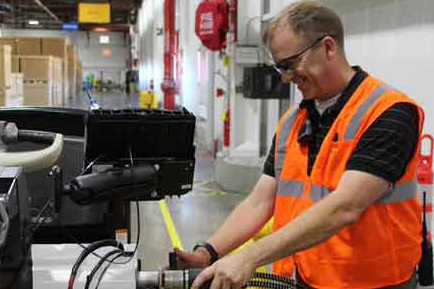While it has always been considered a vital role, the responsibility of procuring industrial applications and materials has been especially important in today’s social climate. Acquiring stainless steel, in particular, has become significantly more difficult.
Stainless Steel World Americas had the pleasure of talking to Victoria Armstrong, Project Control Manager at Plug Power, which was recently acquired by Joule, about what a position in the procurement entails, the challenges of acquiring stainless steel during a global pandemic, and why transitioning into the world of hydrogen liquefication will be important next steps for the industry.
By Sara Mathov
Armstrong has been working in the procurement industry for several years. She joined the Joule Processing team in 2018 and has had a primary focus on procuring materials and applications such as stainless steel and heat exchangers, for midstream applications involving natural gas.
Since working at Joule, Armstrong progressed from her initial position as a Project Coordinator to Procurement Lead, before taking on her current position as a Projects Control Manager. Although her role as a project control manager focuses more on project management than procurement, Armstrong’s multiple years as a procurement lead has made her an expert on the current ins and outs of the procurement industry.

What is Procurement?
Procurement, by definition, is the process of acquiring goods and/or services to distribute them. For an EPC company like Joule, this process entails interacting with manufacturers from the approved vendors list (AVL) to acquire materials and distribute them to its customers.
More specifically, procurement is used as an overarching term for processes such as: purchasing, sourcing, requisitions, and purchase orders. The act of procurement involves various steps, all of which provide the necessary insight into how to assess costs and how to minimize spending while enhancing efficiency by streamlining the purchasing process.
As the former procurement lead, Armstrong has overseen the procurement of heat exchangers, vessels, and other engineered equipment while simultaneously sourcing and acquiring vendors to become pre-qualified for the projects her company undertakes.
Approved Vendors List
There are several factors that are taken into consideration before a vendor will be considered for placement on an AVL. This list acts as a scorecard of pros and cons for each of the potential vendors. It is a method of detailing whether there were prior issues dealing with said vendor, and if Joule would be willing to work with them for future projects. Finding the ideal vendor goes far beyond assuring they have the necessary product. It also includes making sure they abide by safety regulations.
“Safety is incredibly important at Joule. For us to work with a company, we need to make sure they abide by all the necessary safety precautions, as well as being OSHA certified,” said Armstrong. “While a vendor could check all the boxes on paper, if our quality control inspector goes out and notices issues with the facility, we cannot go forward with using them. Safety must always come first.” Aside from safety, cost also plays a role in whether procuring from a manufacturer is worthwhile.
Heat Exchangers and Stainless Steel
“When we work on a project, we purchase everything. For example, heat exchangers, pressure vessels, control valves, instrumentation, manual valves, and at times, we also purchase filters, pumps, ESDs and PSVs. Essentially everything that goes on a skid. Heat exchangers, I would say, are quite a large percentage of our spending on a skid; it is a complicated application and it is very important that we make sure all aspects of it are correct,” explained Armstrong. “From the process standpoint, the size of the heat exchanger also matters because it dictates the size of the skid. The competitiveness on price and delivery also plays a role, especially the delivery, because at times we have a very limited window to deliver it. Therefore, timing plays a role because I might select a heat exchanger with a shorter lead time.”
In addition to project skids, Armstrong has also worked on creating full models of plants. “For this service we require sizing, data sheets, and a number of other requirement specifications from our vendors; we use these to create 3D models as a deliverable,” she said. For valves, instrumentation, and materials specifically, Armstrong explained that many customers have their own approved lists and preferred vendors.

Procuring Stainless Steel and its Difficulties
One of the primary issues the procurement industry has been facing is finding reliable stainless steel sources. Over the last few years, the cost of stainless steel, as well as its availability, has made it difficult to acquire.
“With the pandemic, and other ongoing crises, we are noticing that not only is the price of stainless steel going up, but the availability is low. I can no longer go to a customer and guarantee a delivery date, as I must work with my supply chain to understand when they will have stock in,” explained Armstrong. She noted that there have been shortages with aluminum, among other materials, as well.
As most stainless steel is sourced from China and Europe, delivery times have been drastically altered; shipments have become less frequent and increasingly unreliable. “I no longer have long validity dates, because of the volatility of the market,” said Armstrong. “It is important that individuals in a procurement position understand the new challenges, and how to manage them, to differentiate yourself as a vendor from your competition. Overcommunicating is essential to help ensure trust as a vendor.”
Remaining in constant communication with all the individuals involved in the procurement and delivery process is therefore essential. To operate smoothly, everyone involved should be privy to when the order is set to arrive. This has been a learning curve for vendors and companies alike; the inability to confirm a delivery date has made the ability to explain the market to customers a crucial part of a procurement professionals’ role.
Looking to the Future
Joule has begun to focus on what its next steps look like, in response to the renewed push towards environmental responsibility. “We have been looking towards the use of hydrogen liquefaction technology, nitrogen recovery units, and other technologies that produce not just hydrocarbons, but liquefied hydrogen,” stated Armstrong.
With the process of hydrogen liquification becoming more prevalent, stainless steel is becoming increasingly important for piping and equipment, to handle extremely low temperatures. “The material selection is becoming very important. Before, I could go to a heat exchanger event and request a run of the mill carbon steel exchanger and it would service most applications. Now, with the added requirements for extremely low temperatures, the stainless steel must meet several additional standards.” To address this growing trend, Joule is making a conscious effort to offer applications for the hydrogen transition. For low temperature, Armstrong said the company currently uses a significant amount of 316L.
Hydrogen liquefication occurs when gaseous hydrogen is liquefied by cooling it to below -253°C or -423°F. Once this occurs, the liquefied hydrogen can be stored in large, insulated tanks within a liquefaction plant. While liquefaction plants use between 30 and 35% of a plants energy, making it rather costly, hydrogen in a liquified state can be stored for longer and in larger quantities making it cost efficient.
“Hydrogen can be used on vehicles and fuel cells, or can be used on trucks, so we are fully on board on this hydrogen train. We believe that this is the future, and this is where the industry is going to go. As a result, we are completely retooling and reviewing our AVL,” explained Armstrong. “We are hiring specialists who know about this industry, as we see the future as being more of a hydrogen driven than hydrocarbon driven.”
Armstrong also noted how she sees Joule pivoting towards integrating more unique materials into their processes, such as using vacuum chambers in place of formerly used carbon steel as a method of containing the heat exchangers within the material. The constant influx of new materials and technologies makes the procurement of goods an ever evolving process.
“A lot more customers have been coming to us for quotes on engineering studies. The energy transition, including hydrogen and fuel cells, seems to be really picking up speed. I am very excited for the new inventions and ideas and this could lead to,” said Armstrong.
In Conclusion
The procurement industry has seen change over the last few years. What began as a role that sourced manufacturers and distributing materials to buyers, has turned into an interpersonal career, prompting those within the industry to stay in constant communication as a means to provide the best service possible with the most accurate delivery times.
This new way of forming relationships within the industry is one that has been both beneficial and informative to all involved in the process, indicating that it will be here to stay long after the material shortage is remedied.
Joule Processing at a Glance
Joule was acquired by Plug, a leading provider of turnkey hydrogen solutions for the global green hydrogen economy in January 2022. Joule’s liquefaction process is being deployed in Plug ‘s green hydrogen plants, most specifically the production plant under development in Texas.
Joule Processing is an engineering, process equipment, services and process optimization company dedicated to finding new and better ways to meet the needs of midstream operators. Their work with pipeline and midstream companies has aided them in becoming a prominent name within the industry since being founded in 2009.

